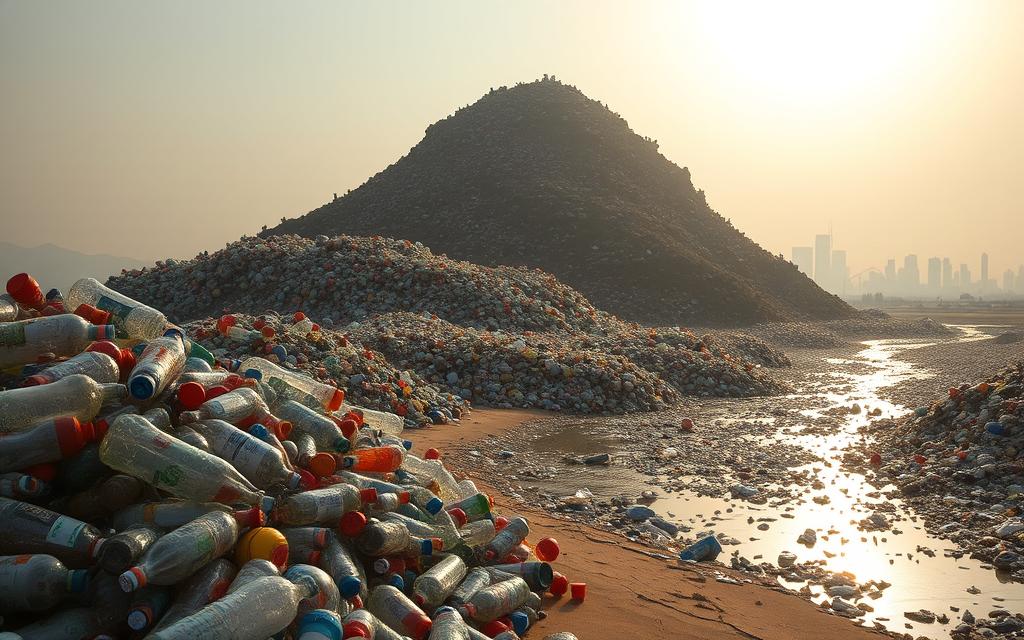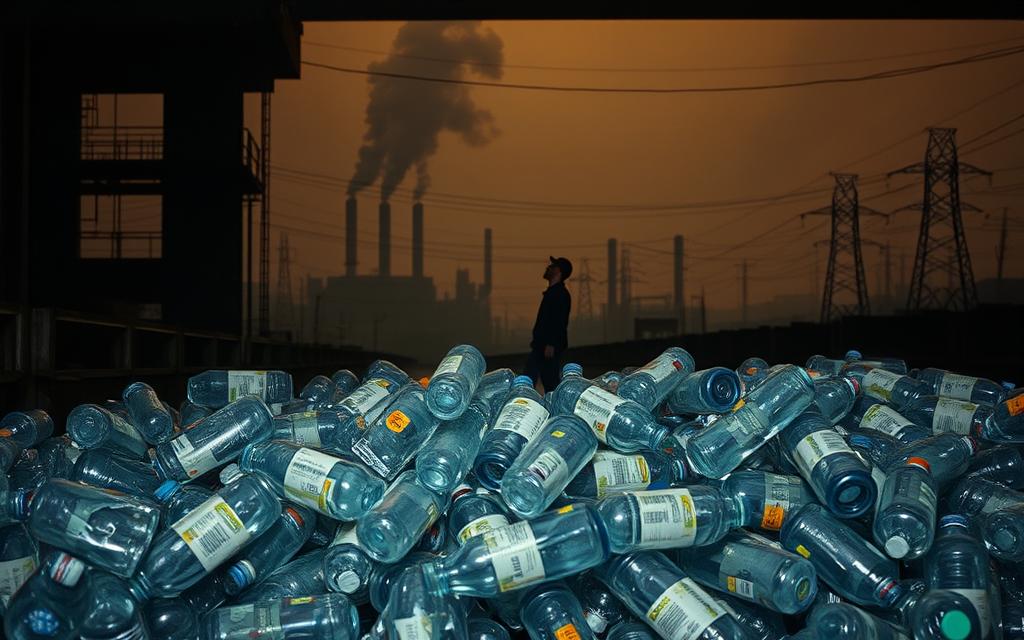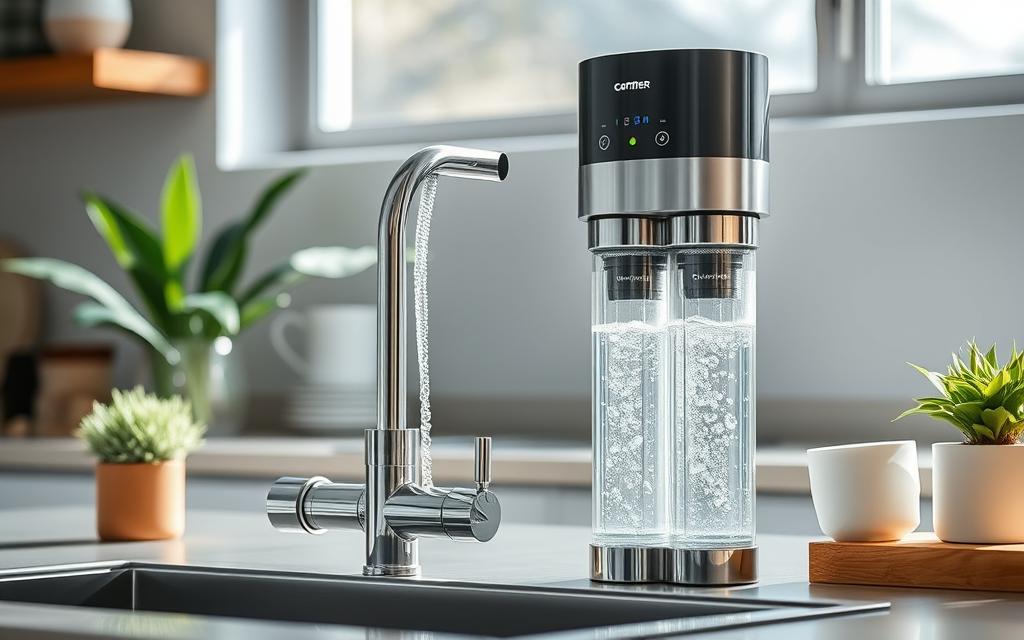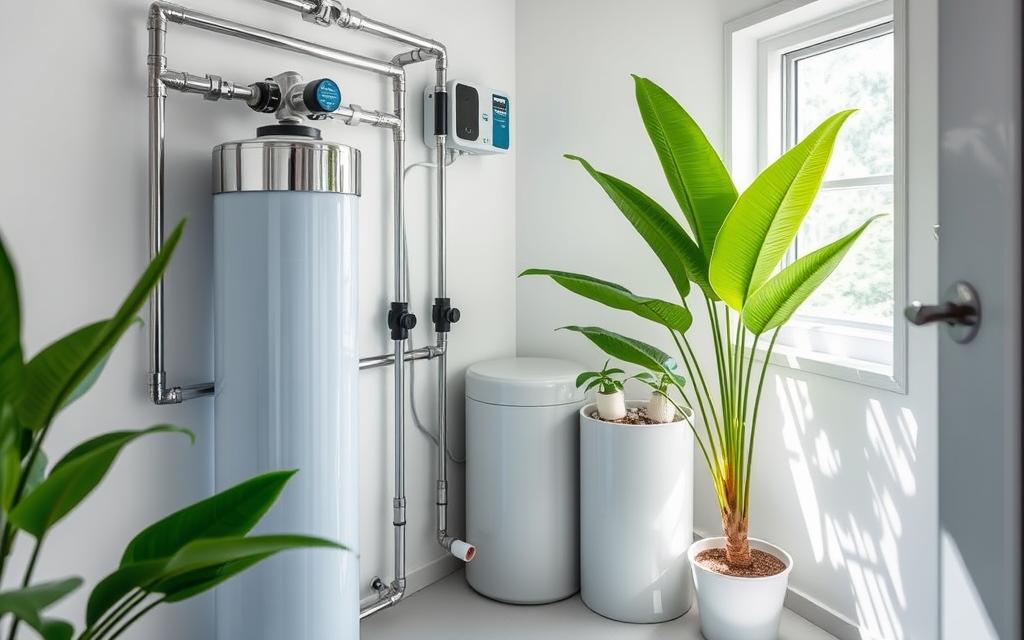Ever thought about the harm a simple plastic water bottle might cause? The bottled water industry claims its products are clean and refreshing. But, there are big environmental and health issues that might shock you.
I’ve looked into how bottled water affects our planet. The CDC says drinking water in the U.S. is very safe. Yet, bottled water brings big problems we can’t ignore.
In this article, I’ll share the main issues with bottled water. It’s why many people are choosing tap water over plastic bottles. The truth about bottled water is more complex than you might think.
Key Takeaways
- Bottled water creates significant plastic waste
- Production processes consume extensive water resources
- Potential chemical leaching from plastic bottles
- Higher environmental carbon footprint compared to tap water
- Recycling rates for water bottles remain critically low
The Environmental Impact of Bottled Water

The effects of bottled water go beyond just convenience. My research shows a worrying picture of how our choices harm the planet. Plastic pollution from bottled water is a major global problem that needs our urgent action.
Water Resource Depletion
Water usage is a big issue with bottled water. It takes a lot of water to make one plastic water bottle. Here’s a look at the water waste:
- 3 liters of water are used to produce 1 liter of bottled water
- Approximately 17 million barrels of oil are consumed annually for bottle production
- Water extraction for bottling disrupts local ecosystems
Plastic Waste and Pollution
The amount of plastic waste from bottled water is huge. Millions of plastic bottles end up in landfills and oceans every single day. In the United States, we throw away over 50 billion plastic water bottles a year. Only about 30% of them get recycled.
Carbon Footprint of Production and Transport
The journey of a bottled water product creates a lot of carbon emissions. From making to moving and cooling, each bottle has a big environmental impact. Moving water long distances adds a lot to greenhouse gas emissions. Tap water is much better for the climate.
“Every bottle we choose has consequences beyond our immediate consumption.” – Environmental Research Team
Health Concerns Related to Bottled Water
Drinking bottled water might seem easy, but it has big health risks. Many people don’t know about these dangers. Research shows bottled water can harm your health over time.
The dangers of bottled water go beyond just not being enough to drink. Chemicals in the plastic can get into your water. This is a big health threat with serious long-term effects.
Chemicals from Plastic Bottles
Plastic bottles can leak harmful chemicals into your water. Some big worries are:
- BPA (Bisphenol A) which may disrupt hormone systems
- Phthalates that potentially impact reproductive health
- Microplastics that can accumulate in human body tissues
A 2018 study found that 93% of bottled water samples contained microplastic contamination. This shows a big risk to your health from drinking bottled water.
Contamination Risks
Drinking bottled water also has other risks. Bacteria can grow and water sources can get contaminated. This adds to the health problems.
- Improper storage can accelerate bacterial proliferation
- Reused bottles increase contamination risk
- Inconsistent water quality testing
Consumers must stay alert about their drinking water choices to keep their health safe.
Knowing these risks helps you make better choices about your water. You can find safer options.
Cost Comparison: Bottled Water vs. Tap Water
The debate between bottled water and tap water is not just about taste and convenience. It also affects your wallet in big ways. People often don’t realize how much bottled water really costs, beyond the price on the bottle.
Here are some financial downsides of using bottled water:
- A single bottle of water can cost up to $2-$3, compared to virtually free tap water
- Annual bottled water expenses can reach $500-$1,000 per person
- Bottled water is approximately 2,000 times more expensive than tap water
Price Discrepancy Over Time
The long-term cost of bottled water is huge. A family of four could save hundreds or thousands of dollars a year by using tap water instead.
“Your bottled water habit is not just impacting the environment—it’s draining your bank account.” – Water Conservation Expert
Hidden Costs of Bottled Water
Bottled water has more costs than just the price you pay:
- Environmental cleanup costs
- Plastic production expenses
- Transportation and distribution fees
- Potential health-related medical expenses from chemical exposure
Knowing these costs can help you make better choices about water. You might even save a lot of money.
Bottled Water vs. Filtered Water
The debate over bottled water vs tap water is ongoing. Many are looking for the best drinking water option. Water filtration is a strong contender, tackling health and environmental issues.
Home water filtration systems have many benefits. They make tap water taste better and safer to drink. This is a big plus for those concerned about bottled water’s impact on the environment.
Benefits of Water Filtration
- Removes harmful chemicals like chlorine and chloramine
- Improves water taste and quality
- Reduces health risks to the respiratory and skin systems
- Significantly lowers plastic waste generation
Environmental Benefits of Filters
Choosing filtered water has a big impact on sustainability. Let’s look at the environmental benefits:
| Metric | Bottled Water | Filtered Water |
|---|---|---|
| Plastic Waste | High (60 million bottles daily) | Minimal |
| Carbon Emissions | Significant | Very Low |
| Cost per Gallon | $8-$9 | $0.02-$0.05 |
Investing in a quality water filter saves money and helps the environment. It’s clear: filtered water is a sustainable, cost-effective choice over bottled water.
Misleading Marketing Practices
The bottled water industry is great at making marketing stories that mix truth and fiction. As someone who buys bottled water, I’ve seen many tricks that make me question the industry’s honesty. These tricks hurt trust between consumers and the bottled water world.
Many bottled water brands use clever marketing to make their water seem better than it is. They play on what we think about water quality and health. These tricks go beyond just lying about the product.
Health Claims on Labels: Separating Fact from Fiction
Labels on bottled water often make big claims that aren’t backed up by science. I’ve found some common tricks:
- Exaggerated purity statements
- Pseudo-scientific health benefit claims
- Misleading source descriptions
- Visual imagery suggesting pristine natural sources
The Myth of Absolute Purity
Many bottled water brands just sell tap water in fancy bottles. They make their water seem better with cool branding and packaging.
| Marketing Claim | Actual Reality |
|---|---|
| 100% Pure Mountain Water | Filtered Municipal Water |
| Pristine Natural Source | Standard Water Treatment Process |
| Superior Health Benefits | Minimal Scientifically Proven Advantages |
When looking at bottled water marketing, remember that looks and words don’t always mean better water.
Taste and Quality Differences
The debate between bottled water and tap water often focuses on taste and quality. Many think bottled water tastes better, but science says something else.
Blind taste tests show interesting results. Most people can’t tell the difference between tap and bottled water without labels. This makes us question the idea that bottled water is always better.
Regional Tap Water Variations
Water taste changes a lot based on local minerals and treatment. Some areas have water with natural minerals that affect taste. Others use different ways to purify water.
- Mineral composition affects water taste
- Local treatment methods influence flavor profiles
- Geographic location plays a big role in water quality
Bottled Water Sourcing Secrets
Many bottled water brands get their water from public supplies. This means people are often paying more for water that’s just filtered tap water.
Up to 64% of bottled water comes from public water systems, not pristine mountain springs.
Knowing these facts can help people choose better. It can also save money and reduce harm to the environment.
Recycling Challenges with Bottled Water
Plastic pollution from bottled water is a big problem. Every day, millions of plastic water bottles are thrown away in the U.S. This creates huge waste management issues that harm our environment.
The issues with bottled water sustainability are complex. Despite many recycling efforts, recycling plastic bottles is very hard.
Understanding Low Recycling Rates
Recycling rates for plastic water bottles are very low. Studies show:
- Only 9% of plastic water bottles are recycled.
- About 60 million bottles are thrown away daily in the U.S.
- Most plastic bottles end up in landfills or nature.
Contamination Problems in Recycling
The recycling process for plastic water bottles has big contamination problems. Residual liquids, food particles, and mixed plastic types make recycling hard.
| Recycling Challenge | Impact |
|---|---|
| Liquid Contamination | Reduces recyclability of bottles |
| Mixed Plastic Types | Complicates sorting processes |
| Label Adhesives | Creates additional processing difficulties |
My research shows we need more than recycling to tackle plastic pollution from bottled water. We must focus on reducing waste and finding better packaging solutions.
Alternatives to Bottled Water
The debate over bottled water vs tap water is ongoing. People are looking for healthy and green ways to stay hydrated. Luckily, there are many good alternatives that can save you money and help the planet.
Reusable Water Bottles: Your Eco-Friendly Companion
Getting a good reusable water bottle is a smart move. It helps you avoid using plastic bottles all the time. There are many types of bottles to fit your style:
- Stainless steel bottles – Durable and long-lasting
- Glass bottles – Chemical-free and easy to clean
- BPA-free plastic bottles – Lightweight and affordable
Water Filtration Systems: Clean Water at Your Fingertips
Water filtration systems are a great way to make tap water better. They range from simple pitcher filters to more complex under-sink systems. These can cut down on harmful substances and make water taste better.
“A home filtration system can transform tap water into a refreshing, safe drinking experience.” – Water Quality Expert
By using reusable bottles and water filters, you can tackle the issues with bottled water. You’ll get clean, tasty water without harming the environment.
Regulatory Issues with Bottled Water
The bottled water industry faces many regulatory challenges. As a consumer, I’ve found that bottled water oversight is surprisingly lax.
The rules for bottled water are complex and critical for consumers to understand. Unlike tap water, which the Environmental Protection Agency (EPA) watches over, bottled water is under the Food and Drug Administration’s (FDA) watch.
Gaps in Regulatory Oversight
The downsides of drinking bottled water are clear when we look at the regulatory gaps:
- FDA rules are less strict than EPA standards
- Bottled water is tested less often
- Many contaminants are not regulated
Comparative Regulatory Standards
Now, let’s compare the main differences in regulations for bottled and tap water:
| Regulatory Aspect | Tap Water | Bottled Water |
|---|---|---|
| Governing Body | EPA | FDA |
| Testing Frequency | Multiple times daily | Infrequent testing |
| Contaminant Tracking | Comprehensive monitoring | Limited oversight |
It’s important for consumers to know that bottled water is not inherently safer just because it’s in a sealed container. The current rules leave a lot of room for quality concerns.
Convenience vs. Sustainability
The appeal of bottled water is clear. We often grab a drink quickly, ignoring the big picture. In today’s fast world, we value ease over the planet’s health.
Let’s look at the true cost of this ease:
- Plastic making needs a lot of energy
- Single-use bottles lead to a lot of waste
- Shipping bottled water adds to carbon emissions
Accessibility and Environmental Trade-offs
In 2016, the U.S. bottled water industry used 4 billion pounds of plastic. This is like 64 million barrels of oil. The harm from bottled water goes beyond just convenience.
Here are some smart ways to stay hydrated while caring for the planet:
- Buy a good reusable water bottle
- Use portable water filters
- Keep filtered water in glass at home and work
Rethinking Our Hydration Habits
Choosing sustainable options makes a big difference. Our choices together have a big environmental effect. By changing how we think about convenience, we can stay hydrated and protect the planet.
Trends in Bottled Water Consumption
The bottled water industry has seen big changes. People are now more health and environment aware. This has led to new trends in how we drink bottled water.
Sparkling water is a big change in the industry. People are choosing it over sugary drinks. This shows a move towards better drink choices.
The Rise of Sparkling Water
Sparkling water brands are getting very popular. Consumers want:
- Zero-calorie hydration options
- Innovative flavor combinations
- Convenient and trendy beverage choices
Changing Consumer Preferences
Now, people care more about the environment when choosing drinks. This is making them change how they buy bottled water.
Blind taste tests show an interesting fact: only 36% of participants can actually distinguish between tap water and bottled water. This makes people think twice about their choices.
Key preference shifts include:
- Increased demand for sustainable packaging
- Growing interest in locally sourced water
- Preference for brands with transparent sourcing practices
The future of bottled water lies in sustainability and innovation.
As people care more about the environment, the bottled water industry must change. Brands that focus on being green and offer unique drinks will do well.
Conclusion: Making Informed Choices
After looking into the bottled water vs tap water debate, I found some key points. Two big downsides of bottled water are the harm to the environment and possible health risks. Tap water is often a better choice for most people in the U.S.
The production and disposal of plastic bottles have a big environmental impact. Each bottle uses a lot of resources, from water to manufacturing and shipping. This leads to a lot of carbon emissions and plastic pollution, harming our planet.
There are also health concerns with bottled water. Many bottled waters contain microplastics and chemicals that could be harmful over time. On the other hand, tap water is tested regularly and is generally safer and clearer.
I suggest looking into eco-friendly options like reusable water bottles and home water filters. These choices help the environment and are also cheaper and healthier. By knowing more about our water use, we can make better choices for ourselves and the planet.



